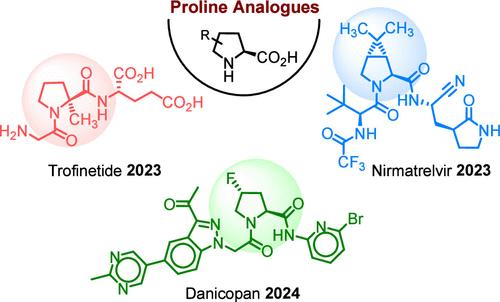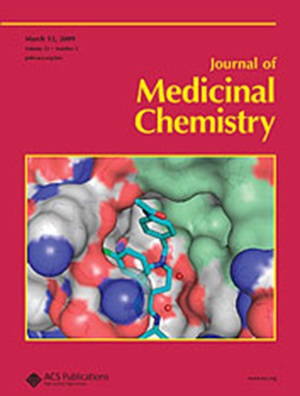药物设计中的脯氨酸类似物:当前趋势与未来展望
IF 6.8
1区 医学
Q1 CHEMISTRY, MEDICINAL
引用次数: 0
摘要
脯氨酸类似物是用途广泛的化学构件,可以模块化构建小分子药物和药用肽。在过去 15 年中,美国食品及药物管理局已批准了超过 15 种结构中含有脯氨酸类似物的药物,仅在过去三年中就批准了 5 种(daridorexant、trofinetide、nirmatrelvir、rezafungin 和 danicopan)。本视角分析了目前药物设计中最常见的脯氨酸类似物类型。我们重点举例说明了氟脯氨酸、α-甲基脯氨酸、双环脯氨酸类似物和氨基脯氨酸,同时也强调了代表性不足的脯氨酸类似物。我们在分析中补充了有关这些分子的特定分子特性的理化信息。此外,我们还讨论了用脯氨酸类似物取代非脯氨酸残基以消除不需要的氢键供体位点的几个有趣案例。最后,我们为今后探索这类在药物发现中大有可为的分子实体提出了一些建议。本文章由计算机程序翻译,如有差异,请以英文原文为准。

Proline Analogues in Drug Design: Current Trends and Future Prospects
Proline analogues are versatile chemical building blocks that enable modular construction of small-molecule drugs and pharmaceutical peptides. Over the past 15 years, the FDA has approved over 15 drugs containing proline analogues in their structures, five in the last three years alone (daridorexant, trofinetide, nirmatrelvir, rezafungin, danicopan). This perspective offers an analysis of the most common types of proline analogues currently trending in drug design. We focus on examples of fluoroprolines, α-methylproline, bicyclic proline analogues, and aminoprolines, while also highlighting proline analogues that remain underrepresented. We supplement our analysis with physicochemical information regarding the specific molecular properties of these moieties. Additionally, we discuss several intriguing cases where nonproline residues were replaced with proline analogues as a strategy to eliminate unwanted hydrogen bond donor sites. In conclusion, we present some suggestions for the future exploration of this promising class of molecular entities in drug discovery.
求助全文
通过发布文献求助,成功后即可免费获取论文全文。
去求助
来源期刊

Journal of Medicinal Chemistry
医学-医药化学
CiteScore
4.00
自引率
11.00%
发文量
804
审稿时长
1.9 months
期刊介绍:
The Journal of Medicinal Chemistry is a prestigious biweekly peer-reviewed publication that focuses on the multifaceted field of medicinal chemistry. Since its inception in 1959 as the Journal of Medicinal and Pharmaceutical Chemistry, it has evolved to become a cornerstone in the dissemination of research findings related to the design, synthesis, and development of therapeutic agents.
The Journal of Medicinal Chemistry is recognized for its significant impact in the scientific community, as evidenced by its 2022 impact factor of 7.3. This metric reflects the journal's influence and the importance of its content in shaping the future of drug discovery and development. The journal serves as a vital resource for chemists, pharmacologists, and other researchers interested in the molecular mechanisms of drug action and the optimization of therapeutic compounds.
 求助内容:
求助内容: 应助结果提醒方式:
应助结果提醒方式:


